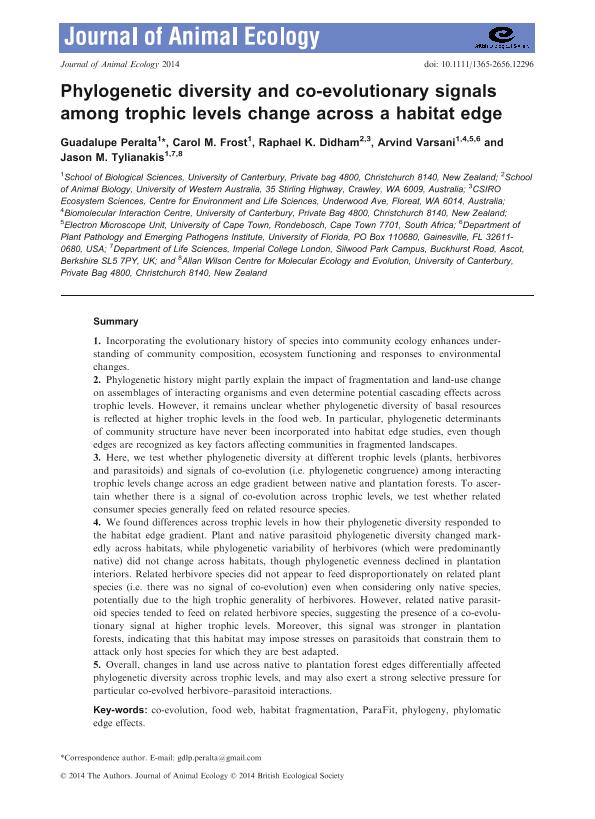Mostrar el registro sencillo del ítem
dc.contributor.author
Peralta, Guadalupe

dc.contributor.author
Frost, Carol
dc.contributor.author
Didham, Raphael
dc.contributor.author
Varsani, Arvind
dc.contributor.author
Tylianakis, Jason
dc.date.available
2018-05-18T19:54:51Z
dc.date.issued
2015-10
dc.identifier.citation
Peralta, Guadalupe; Frost, Carol; Didham, Raphael; Varsani, Arvind; Tylianakis, Jason; Phylogenetic diversity and coevolutionary signals among trophic levels change across a habitat edge gradient; Wiley Blackwell Publishing, Inc; Journal Of Animal Ecology; 84; 2; 10-2015; 1-9
dc.identifier.issn
0021-8790
dc.identifier.uri
http://hdl.handle.net/11336/45637
dc.description.abstract
1. Incorporating the evolutionary history of species into community ecology enhances understanding of community composition, ecosystem functioning and responses to environmental changes. 2. Phylogenetic history might partly explain the impact of fragmentation and land-use change on assemblages of interacting organisms, and even determine potential cascading effects across trophic levels. However, it remains unclear whether phylogenetic diversity of basal resources is reflected at higher trophic levels in the food web. In particular, phylogenetic determinants of community structure have never been incorporated into habitat edge studies, even though edges are recognised as key factors affecting communities in fragmented landscapes. 3. Here we test whether phylogenetic diversity at different trophic levels (plants, herbivores, parasitoids) and signals of coevolution (i.e. phylogenetic congruence) among interacting trophic levels change across an edge gradient between native and plantation forests. To ascertain whether there is a signal of coevolution across trophic levels, we test whether related consumer species generally feed on related resource species. 4. We found differences across trophic levels in how their phylogenetic diversity responded to the habitat edge gradient. Plant and native parasitoid phylogenetic diversity changed markedly across habitats, while phylogenetic variability of herbivores (which were predominantly native) did not change across habitats, though phylogenetic evenness declined in plantation interiors. Related herbivore species did not appear to feed disproportionately on related plant species (i.e. there was no signal of coevolution) even when considering only native species, potentially due to the high trophic generality of herbivores. However, related native parasitoid species tended to feed on related herbivore species, suggesting the presence of a coevolutionary signal at higher trophic levels. Moreover, this signal was stronger in plantation forests, indicating that this habitat may impose stresses on parasitoids that constrain them to attack only host species for which they are best adapted. 5. Overall, changes in land use across native to plantation forest edges differentially affected phylogenetic diversity across trophic levels, and may also exert a strong selective pressure for particular coevolved herbivore-parasitoid interactions.
dc.format
application/pdf
dc.language.iso
eng
dc.publisher
Wiley Blackwell Publishing, Inc

dc.rights
info:eu-repo/semantics/openAccess
dc.rights.uri
https://creativecommons.org/licenses/by-nc-sa/2.5/ar/
dc.subject
Co-Evolution
dc.subject
Food Web
dc.subject
Habitat Fragmentation
dc.subject
Parafit
dc.subject
Phylogeny
dc.subject
Phylomatic
dc.subject
Edge Effects
dc.subject.classification
Otras Ciencias Biológicas

dc.subject.classification
Ciencias Biológicas

dc.subject.classification
CIENCIAS NATURALES Y EXACTAS

dc.title
Phylogenetic diversity and coevolutionary signals among trophic levels change across a habitat edge gradient
dc.type
info:eu-repo/semantics/article
dc.type
info:ar-repo/semantics/artículo
dc.type
info:eu-repo/semantics/publishedVersion
dc.date.updated
2018-04-18T17:51:45Z
dc.journal.volume
84
dc.journal.number
2
dc.journal.pagination
1-9
dc.journal.pais
Reino Unido

dc.journal.ciudad
Londres
dc.description.fil
Fil: Peralta, Guadalupe. University Of Canterbury; Nueva Zelanda. Consejo Nacional de Investigaciones Científicas y Técnicas. Centro Científico Tecnológico Conicet - Mendoza. Instituto Argentino de Investigaciones de las Zonas Áridas. Provincia de Mendoza. Instituto Argentino de Investigaciones de las Zonas Áridas. Universidad Nacional de Cuyo. Instituto Argentino de Investigaciones de las Zonas Áridas; Argentina
dc.description.fil
Fil: Frost, Carol. University Of Canterbury; Nueva Zelanda
dc.description.fil
Fil: Didham, Raphael. University of Western Australia; Australia. Csiro Ecosystem Sciences, Centre For Environment And Li; Australia
dc.description.fil
Fil: Varsani, Arvind. University Of Canterbury; Nueva Zelanda. Electron Microscope Unit, University Of Cape Town; Sudáfrica. University Of Florida; Estados Unidos. Biomolecular Interaction Centre; Nueva Zelanda
dc.description.fil
Fil: Tylianakis, Jason. Imperial College London; Reino Unido. Allan Wilson Centrefor Molecular Ecology And Evolution; Nueva Zelanda. University Of Canterbury; Nueva Zelanda
dc.journal.title
Journal Of Animal Ecology

dc.relation.alternativeid
info:eu-repo/semantics/altIdentifier/doi/http://dx.doi.org/10.1111/1365-2656.12296
dc.relation.alternativeid
info:eu-repo/semantics/altIdentifier/url/https://besjournals.onlinelibrary.wiley.com/doi/abs/10.1111/1365-2656.12296
Archivos asociados
